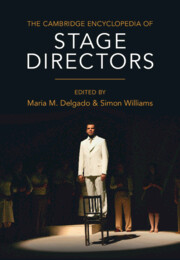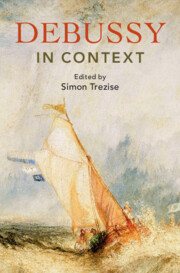Refine search
Actions for selected content:
78 results
Chapter 3 - Symbolism and Expressionism
- from Part I - Forms and Genres
-
-
- Book:
- The Cambridge Companion to Modernist Theatre
- Published online:
- 28 August 2025
- Print publication:
- 11 September 2025, pp 55-71
-
- Chapter
- Export citation
4 - Interlude: Earliness as an Aesthetic Category
-
- Book:
- Anton Webern at the Dawn of Modernism
- Published online:
- 21 August 2025
- Print publication:
- 04 September 2025, pp 85-93
-
- Chapter
- Export citation
Chapter 32 - Poetry, Literature and Language
- from Part VIII - Ideas, Beliefs and Interventions
-
-
- Book:
- Schoenberg in Context
- Published online:
- 04 September 2025
- Print publication:
- 04 September 2025, pp 316-324
-
- Chapter
- Export citation
Chapter 11 - Atonality
- from Part III - Approaches to Composition
-
-
- Book:
- Schoenberg in Context
- Published online:
- 04 September 2025
- Print publication:
- 04 September 2025, pp 108-121
-
- Chapter
- Export citation

The Cambridge Encyclopedia of Stage Directors
-
- Published online:
- 19 June 2025
- Print publication:
- 03 July 2025
10 - Papacy and Marriage
- from Part II - Women, Gender, Sexuality
-
-
- Book:
- The Cambridge History of the Papacy
- Published online:
- 28 February 2025
- Print publication:
- 20 March 2025, pp 302-329
-
- Chapter
- Export citation
Chapter Four - Structures of immorality: Rhetoric, building and social hierarchy
-
- Book:
- The Politics of Immorality in Ancient Rome
- Published online:
- 28 February 2025
- Print publication:
- 06 March 2025, pp 137-172
-
- Chapter
- Export citation
6 - Experiment and Adaptation
- from Part II - Networks
-
-
- Book:
- The Cambridge Companion to Australian Poetry
- Published online:
- 06 June 2024
- Print publication:
- 13 June 2024, pp 101-118
-
- Chapter
- Export citation
5 - A Cognitive Revolution
-
- Book:
- The Archaeology of Southern Africa
- Published online:
- 15 May 2024
- Print publication:
- 06 June 2024, pp 85-124
-
- Chapter
- Export citation

Debussy in Context
-
- Published online:
- 23 May 2024
- Print publication:
- 23 May 2024
Chapter 7 - Symbolism
- from Part II - The Arts
-
-
- Book:
- Debussy in Context
- Published online:
- 23 May 2024
- Print publication:
- 23 May 2024, pp 69-78
-
- Chapter
- Export citation
Chapter 23 - Composing for Opera and Theatre outside Established Genres
- from Part V - The Music of Debussy’s Time
-
-
- Book:
- Debussy in Context
- Published online:
- 23 May 2024
- Print publication:
- 23 May 2024, pp 211-219
-
- Chapter
- Export citation
Chapter 14 - Relationships with Poets and Other Literary Figures
- from Part III - People and Milieu
-
-
- Book:
- Debussy in Context
- Published online:
- 23 May 2024
- Print publication:
- 23 May 2024, pp 135-142
-
- Chapter
- Export citation
Chapter 8 - Modernism
- from Part II - The Arts
-
-
- Book:
- Debussy in Context
- Published online:
- 23 May 2024
- Print publication:
- 23 May 2024, pp 79-87
-
- Chapter
- Export citation
Chapter 2 - “A Dream-Heavy Land”
-
- Book:
- Yeats, Revival, and the Temporalities of Irish Modernism
- Published online:
- 11 April 2024
- Print publication:
- 18 April 2024, pp 53-85
-
- Chapter
- Export citation
Chapter 14 - Messiaen’s Musical Language of Religious Symbolism
- from Part II - Messiaen and Theology
-
-
- Book:
- Messiaen in Context
- Published online:
- 09 November 2023
- Print publication:
- 30 November 2023, pp 127-134
-
- Chapter
- Export citation
Chapter 13 - The Theology and Aesthetics of Thomas Aquinas in the Compositions of Olivier Messiaen
- from Part II - Messiaen and Theology
-
-
- Book:
- Messiaen in Context
- Published online:
- 09 November 2023
- Print publication:
- 30 November 2023, pp 119-126
-
- Chapter
- Export citation
14 - Partial Derivatives: Sources, Types, and Tropes in The Magic Flute
- from Part III - Approaches and Perspectives
-
-
- Book:
- The Cambridge Companion to <i>The Magic Flute</i>
- Published online:
- 24 November 2023
- Print publication:
- 02 November 2023, pp 221-233
-
- Chapter
- Export citation
Culture of the Chinese revolution: symbolic and semiotic differences from the world culture of revolution
-
- Journal:
- International Journal of Asian Studies / Volume 20 / Issue 2 / July 2023
- Published online by Cambridge University Press:
- 27 September 2023, pp. 851-873
-
- Article
- Export citation
Jesus’s Secret Journey in John 7: A Symbol of the Ascension
-
- Journal:
- Harvard Theological Review / Volume 117 / Issue 1 / January 2024
- Published online by Cambridge University Press:
- 21 September 2023, pp. 58-78
- Print publication:
- January 2024
-
- Article
- Export citation
